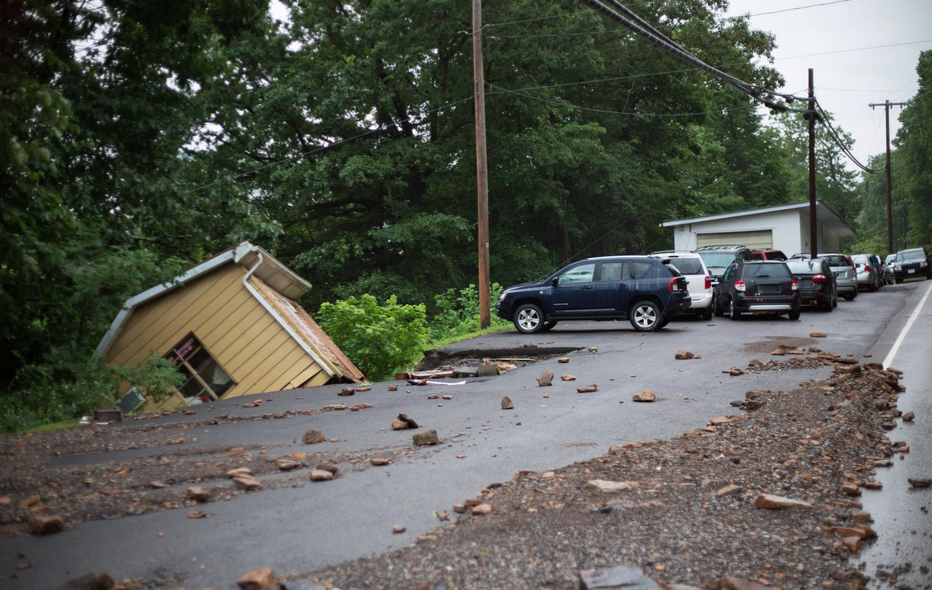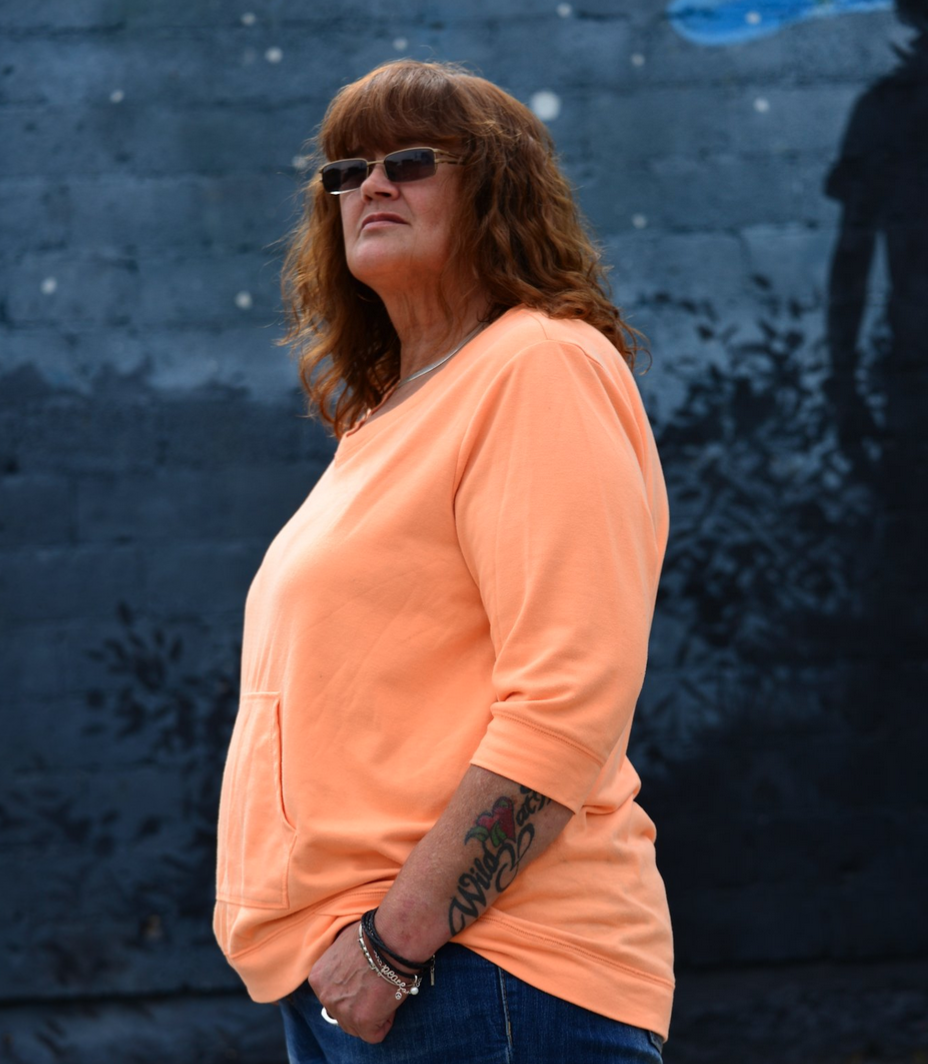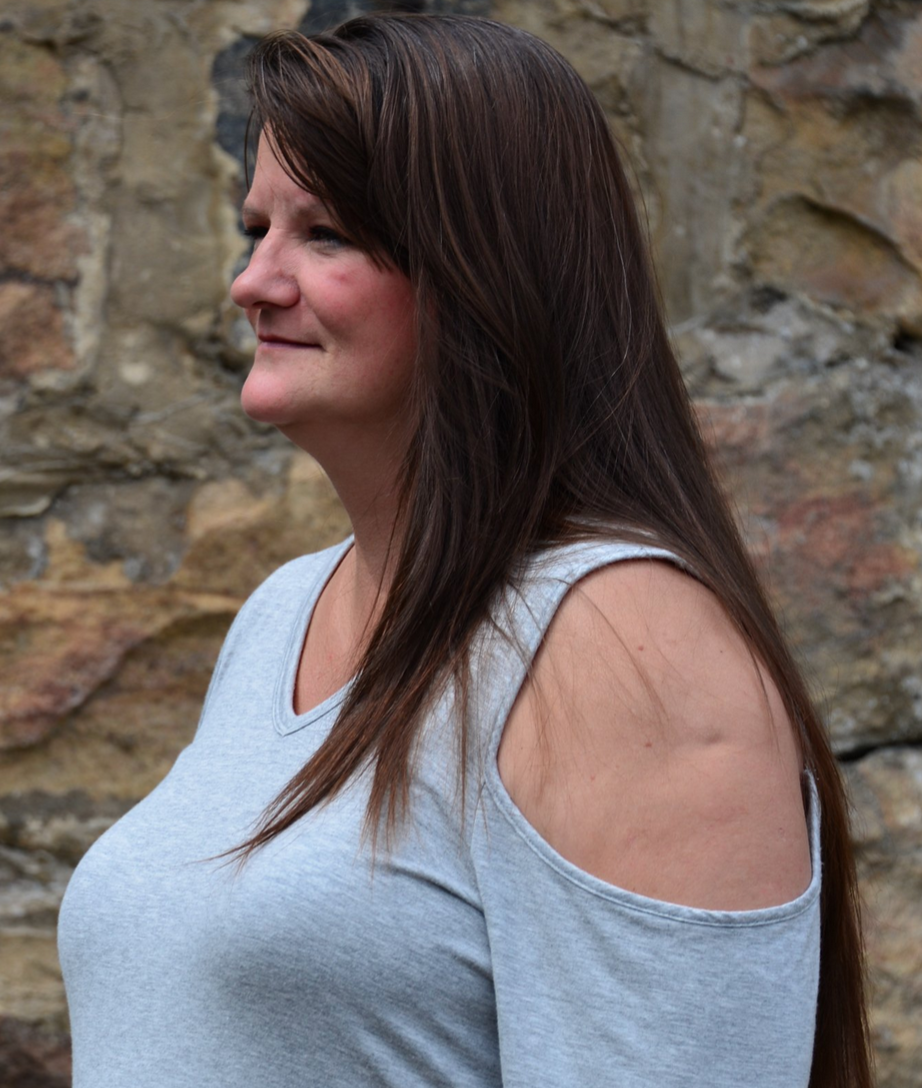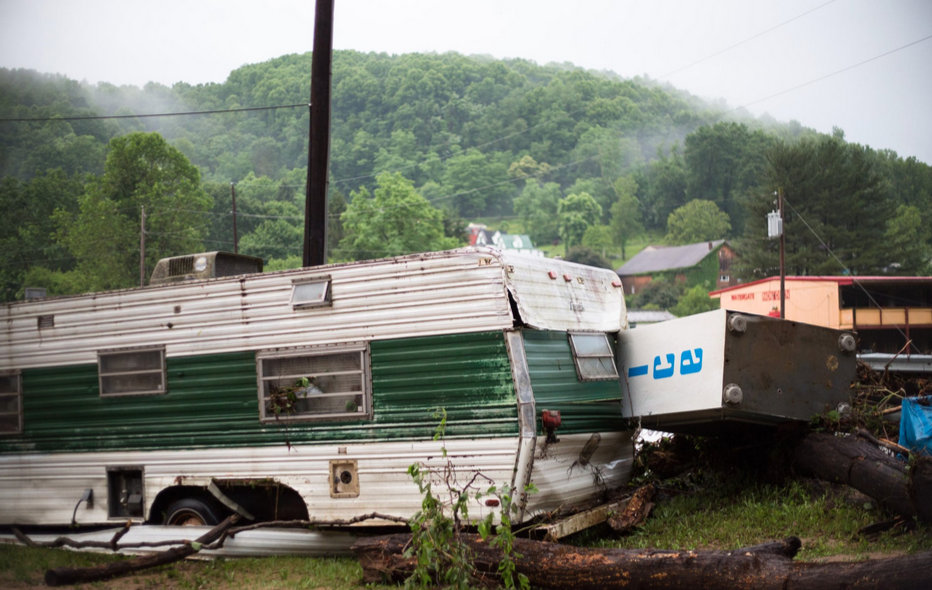
Floods are getting bigger. Photo by Jeromy Rose
Nancy Mullins was working at the Richwood, West Virginia, nursing home on June 23, 2016, when the town began to flood. Her first thought was for her two daughters, who were back at home, a block from the swollen Cherry River. She sped home, got them to safety, then drove back to work in her husband’s truck, through roads already submerged in flood water.
When the town flooded in 2003, the nursing home had moved residents to the rear of the building. They planned to do the same today, but Mullins had seen the flood.
“We’ve got to get these people out of here,” said Mullins, 41, who opens her arms to everyone. A school bus driver commandeered two buses to transport 95 residents several blocks to Liberty Baptist Church. As they moved the residents onto the buses, the water was over Mullins’ knees, and in the laps of the residents in wheelchairs.
Panic set in. Some co-workers froze. But Mullins became a general in the rescue battalion.
“It was like slow motion,” she says. “You got to move, we need teamwork, you hold, you do that. Was happening so fast, no time to react, just had to do. I never saw myself doing this in my whole life.”
The mini army carried fragile elderly, with feeding tubes, IVs and bandaged limbs, out the narrow gap between the back door and retaining wall. Surging waves pushed wheelchairs out from under residents. A torrent of water knocked Mullins down, and she would have drowned had a resident’s son not grabbed her and hauled her back onto her feet.

Downtown Richwood at dawn, after hours of heavy rain flooded the town in June of 2016. Photo by Kara Lofton/West Virginia Public Broadcasting
After several increasingly dangerous trips back and forth, 12 residents remained in the building, but the buses couldn’t wait any longer. The water was rising too fast. The buses left, and Mullins took charge. Using sheets as stretchers, she and the other workers carried the remaining 12 residents through the water to the church.
“Most terrible thing I had to do in my life,” she says.
Not once did she think of her home. She would find it filled up to the kitchen counter with Cherry River overflow, a neighbor’s deck lodged against the back door.
The likelihood of a storm this powerful was just .1 percent. In just a few hours, it dumped nearly nine inches of rain on Richwood. The Cherry River rose over its banks, and this small city’s steep streets funneled torrents of water to the city below. Eighty homes were destroyed; 100 were damaged. The high school and middle school were wrecked. Pavement was shredded; water and sewer pipes twisted and erupted. Roads became rivers.
And none of it had to happen.
This was Richwood’s seventh major flood since 1932. In 2004, West Virginia issued a Flood Protection Plan – 365 pages of recommendations for preventing future flooding that died in the legislature after funding was denied. In 2008, a U.S. Army Corps of Engineers study found that floodwalls could be erected in Richwood for $59 million, but that this 2,000-person town was not significant enough to merit the expense. Instead, the federal government will have to spend at least $130 million to repair the damage.

Heavy rains caused the ground to collapse underneath the Main Street Motors office building in Richwood. Photo by Kara Lofton/West Virginia Public Broadcasting
“That whole thing made me angry then and still does today,” said John Ailes, former head of mining regulation. As a regulator, Ailes fought to control flood runoff from coalmines and logging and helped formulate the 2004 flood plan. As a National Guard member he helped clean up many floods. “Richwood is the poster child for sure. And I hope somehow it makes a comeback.”
Floods are getting bigger. The 2014 National Climate Assessment found that, since 1958, the very largest rainfalls have increased 71 percent from Maine to West Virginia, and 37 percent in Midwest states, from Minnesota to Missouri. While coastal flooding captures the attention of the media, inland floods tend to do greater damage and claim more lives. Many occur in rural communities or poorer parts of cities with no funds for flood protection, forcing the federal government to pick up the tab. Richwood’s year of disaster and recovery tells a common story of despair, confusion, and collateral consequences.
“Why sacrifice poor communities?” says Eric Tate, an associate professor at the University of Iowa who studies the confluence of environmental hazards and society. “What if we made choices not on the value of stuff, but on the vulnerability of people, on cultural values. What would decisions look like then?”
Nestled at the edge of the Monongahela National Forest, Richwood looks like a stretched-out bowl. The Collins Hardwood sawmill, one of the oldest manufacturing sites in West Virginia, covers much of the northeast end. Commerce clusters in flatland near the river: City Hall, the fire department, Richwood Public Library, Rite Aid and Dollar General, and the high school and middle school. Across the Cherry River is Southside, where Mullins lives. Half a mile west are the former National Guard Armory, a medical clinic and the nursing home. A bit further, Laurel Creek Hardwoods, and the Cherry River Elementary School sit on a knoll, safer from flooding.

Peggy Lou Scott. Photo by Photo by Penny Loeb
Peggy Lou Scott was born on a couch on Cranberry Street, high on one of the hills, in 1962. Now she lives nearby. When her washed-out road reopened, she became one of the ordinary heroes of the flood.
“July 1,” she wrote in her journal. “Started going to homes where I saw some activity and talking with people to see what they needed help with. After the first couple of homes, I had to stop before the next one and have my own breakdown – devastation, it’s just a word. I don’t think there are words for what I’m seeing.”
For the first two weeks after the flood, volunteers helped the National Guard clear streets, and strip the walls and floors from ruined buildings before black mold took over. When the Guard left, Scott continued to do what she could. When the Federal Emergency Management Agency wouldn’t bring temporary housing, she and fellow resident Cindy Jo McGraw raised funds for 13 camping trailers. As winter approached, she lay awake at night wondering where she could find heating systems for 100 homes.
“I have to do all I can to help these people pick up the pieces of what is left of their lives – which isn’t much,” Scott wrote in her journal.
On July 3, Robin Brown, a city council member, stood in the stripped interior of her house on Ellen Street, half a block from the Cherry River, feeling both grateful and frustrated. “The volunteers have been amazing,” she said. “People who never knew where Richwood was. They came from Texas, Colorado, North Carolina, South Carolina, Florida.”
FEMA had been less responsive. Three feet of water had filled the house, and mud packed the crawl space, but a FEMA representative estimated the value at just $1,164. “I am overwhelmingly appalled,” she said. She was one of the few townspeople who had flood insurance, but when she called her insurer, they didn’t pick up.
A quarter mile away, recovery workers buzzed around command headquarters in the Family Center on Valley Ave. The recovery team was headed by Jeromy Rose, a sculptor who served a single term as mayor 20 years prior, when he was just 26-years-old. Jon Cox, class of 1987 Richwood High School and an experienced corporate disaster planner, returned from Colorado and converted the Armory into a distribution center for the tons of food, supplies, and furniture pouring in from corporations and charity groups.

Bob Henry Baber. Photo by Penny Loeb
At the command center, current mayor Bob Henry Baber joined yet another hastily convened meeting. Two days before the flood, the 65-year-old Baber had won a second term by a single vote. A poet, an artist and a PhD, Baber wears Richwood’s heart on his sleeve. He fell in love with the town as a boy, when he would spend summers at his grandparents’ Richwood farm where he now lives.
Baber has more experience with floods than most elected officials. In 1977, he helped clean up the largest flood to ever hit Williamson, West Virginia, where over 2,000 people lost their homes. When federal officials set up emergency housing far outside of town, Baber and other volunteers convinced local coal miners to shut down the local coalfield for a day in protest. It worked. The trailers were moved to the city, where residents needed them. In 1991, Williamson got a floodwall, and it hasn’t flooded since.
Baber won his first term as mayor seven months after Richwood’s 2003 flood. He repaired the flooded water-sewer system, fixed sidewalks, and remodeled the former Richwood train depot into the Richwood Convention and Visitors Bureau. This election, his promises were just as bold: revive the “Aspen of the East” with arts, tourism, an ATV trail, and make the city shine again. This afternoon, those dreams were on hold, but not forgotten.
On August 1, 2016, as she had done for the last month, Bonnie Bailey Kroll posted on the “I Am Richwood” Facebook page: “It’s me Bonnie and I am here at my little big spot on Main St. The G.C. Murphys building.”
Richwood’s Main Street is paused between past and potential. Half a century ago, the G.C. Murphy Co. dime store bookended two-dozen stores on Main Street. Boy Scouts bought their uniforms and merit badge books across the street at the Deitz-Spencer department store. “The City Merry on the Banks of the Cherry” was flush with jobs at coalmines, lumberyards and the nation’s largest clothespin factory. Then the railroad shut down, mines closed in the 1980s, and a four-lane highway was built 23 miles away near Summersville, meaning that Route 39, which runs down Main Street, was no longer a key travel route. All but a few stores closed.

Bonnie Bailey Kroll. Photo by Penny Loeb
But this summer the vast floors of G.C. Murphy and Deitz-Spencer overflow with clothes, shoes, bedding, kitchenware, towels, and toys donated by people across the country.
“I got here at about 8:30, and couldn’t get through the door with all the donations out front,” said Linda Jarvis, a licensed practical nurse who lost her job at the nursing home.
“The reason I’m here doing this,” Kroll said, “I was actually lucky in not getting flooded. But I sat at my house and watched all this happen. I grew up in this town and know a lot of these people, and I couldn’t not do my little part.”
Today, Kroll brought four tiny rescued kittens. Tucked in a towel, each took a turn at the milk bottle Jarvis held for them, as she and Kroll discussed the flood.
“FEMA turns people down three times,” Jarvis said. “SBA [Small Business Administration] will let you know.”
“If you have good income,” Kroll said.
“Most people with good income are supporting themselves, maybe one or two of their family and grandchildren,” Jarvis replied. “Even if you have good income, you are giving it all away.”
“I was the one who got up at the FEMA meeting and asked why we didn’t get flood gates, flood walls,” Kroll said. “I was told we didn’t have enough revenue to be feasible.”
“In other words,” Jarvis said, “They don’t care if we wash away.”
On August 1, Mayor Baber was in battle mode. A few days earlier, FEMA told him that while neighboring counties were getting temporary housing, Richwood’s didn’t qualify. No explanation was given.
The flood had wiped out the upgraded water-sewer system. “We discovered, like in 2003, sewer lines are helter skelter all over the river,” Baber explained. “So all sewage is basically going into the river.” The city required no less than a state-of-the-art system, not patchwork repairs.
“My standard speech to FEMA is: ‘You guys only put back what was. What was before the flood wasn’t what it should be. To always replace what was less is not enough.’”
“The hardest thing was trying to save a city while dealing with FEMA,” Rose said. “We had dozens of FEMA personnel come in. Each person had a different interpretation of the law.”
FEMA does not pay upfront, which makes things tough for a city with a $1 million budget and as much as $40 million in damages to city property. Relief would come to those cities that were best able to twist FEMA’s bureaucracy to fulfill their people’s needs. Soon after the flood, consultants arrived, “kind of like ambulance chasers,” Baber said. Richwood was one of only two communities to hire a consultant, whose fees are mostly paid by FEMA. The consultants helped the city get maximum grants from FEMA, $2.3 million so far. They are still negotiating the new water-sewer system, which could cost as much as $15 million.
On the second floor of City Hall, FEMA staff took applications from flood victims. Of the 415 registrations, only 183 people received grants, most for less than $5,000. “Individual assistance cannot compensate for all losses,” explained Daniel Stoneking, director of external affairs for FEMA Region III. “It is intended to meet basic needs and supplement disaster recovery efforts.” Only 77 properties in Richwood had flood insurance.
Two weeks after the flood, Rita DeMario, in scrubs, set off from her North Carolina home to help in West Virginia. Inspired by Mother Theresa, DeMario, in her mid-50s, has journeyed to disasters since 1989, offering a shoulder of hope to the victims. Her mission has taken her to North Carolina and British Columbia, where she worked to repair devastation caused by fires, and she is now in Houston, working to help residents in the aftermath of Hurricane Harvey.
This time, her destination, White Sulphur Springs, didn’t need her; the city was already overwhelmed with 1,800 volunteers. Instead, she found Richwood.
Where FEMA left gaps, she filled them in. Flood damage closed the food pantry, so she and a friend spent two weeks feeding and nursing families trapped in hollows. She compiled a list of 1,001 people in Nicholas County, including Richwood, affected by the flood. This included FEMA applicants, people found going door-to-door and the city’s database of requests for help.
On September 12, she and an assistant worked out of the corner office of the Armory. Two white boards, laid out for the month, tracked which volunteer group will come when, and when truck deliveries are scheduled. Since the flood, 1,100 volunteers had signed in at the Armory.

A battered trailer and ice chest sit beside the river. Photo by Kara Lofton/West Virginia Public Broadcasting
Matching needs to skills and materials was complicated. Faith-based Hosanna Industries and World Servants brought skilled workers. But other times, volunteer abilities don’t match needs. “We have no idea of the skills of the volunteers who come,” DeMario said. “And we don’t have all the necessary materials. We may need roof repairs, but don’t have roofing material.”
Just that afternoon, DeMario’s assistant apologized to a flood victim that there were no volunteers to help her today. The woman wore a handmade pinafore that said “No1 cares.”
DeMario’s pay stopped Oct. 29, when FEMA left Richwood, but she kept helping overlooked flood victims. She found a man who had lost a leg and bought him a wood stove and wood.
“Someone should help them,” she said, “and no one is. I’m not a millionaire; I’m just a normal person.”
Two months later, she was hired to oversee caseworkers provided by West Virginia Voluntary Organizations Active in Disaster (WVVOAD), which had gotten a $5 million FEMA grant to solve unmet needs. But bureaucracy frustrated someone used to comforting disaster victims. “Every time you go to do something another agency says you have to do it this way,” she said. In January, she went home. For several months, requests for help filled up voice mail on her office phone.
By April 2017, three caseworkers from WVVOAD and one from the United Methodist Church began working in Richwood. WVVOAD won a national award for its work, but helping those with unmet needs can take several months, WVVOAD Executive Director Jenny Gannaway explained. Financial help from volunteer groups must wait until after a homeowner has exhausted FEMA and HUD funding possibilities. If donations duplicate any federal money, the homeowner may have to repay. If FEMA rejects them, there’s a lengthy appeals process. Even when the system works, it takes a long, long time before donated dollars reach the people who need them.
Eric Tate, the Iowa professor, saw these complications first hand in 2008, when flooding devastated Iowa City and Cedar Rapids.
“First comes FEMA,” he says. “You have to set up a program [for buyouts], most cities are not very well equipped for that. In the meantime, people are like, ‘Well the flood waters have receded, what am I supposed to do?’ Then a year later there’s an authorization for redevelopment for low-income households through the Department of Housing and Urban Development. There’s a whole other set of rules. People are saying, ‘Why do they have all these contradictory rules?’ We don’t really have a coordinated approach to dealing with floods at the federal level.”
On January 10, 2017, dentist Lloyd Adkins and Jeromy Rose shared lunch at the Oakford diner. While bragging about his children, Adkins pulled out his phone to read something his daughter wrote on Facebook about the flood. Halfway through, he began crying.
Rose put his hand on Adkins’s shoulder. “It’s like we have a thin coating over us. I break down all the time,” he said. “We are a traumatized population.”
The night before, Rose and Adkins watched the Nicholas County Board of Education start the process to consolidate Richwood’s flood-damaged middle and high schools with other schools in the county. The new complex would be 25 miles away, over mountains, near Summersville. To Adkins, a former president of the Board of Education, it was a tragedy.
The schools are the sun around which Richwood revolves. Without them, residents fear the city will fade away. Though two-thirds of the high school’s nearly 400 students are economically disadvantaged, in 2016 U.S. News & World Report ranked the school among the state’s top ten percent. Its marching band, the Lumberjack Express, is the second largest among all small schools in the nation and performs across the country.

Debris from historic heavy rains bent a metal gate outside of the town’s middle school. Photo by Kara Lofton/West Virginia Public Broadcasting
Even after the BOE vote, Richwood residents fought consolidation tooth-and-nail. The issue was $100 million in federal funding, expected from FEMA to repair the city’s schools, that was now being used to build the consolidated complex 25 miles away. The Board of Education had chosen to employ that money under a pilot program, Alternative Procedures, which was introduced in 2013, as part of the Sandy Recovery Improvement Act. Intended to speed rebuilding, the program allows public institutions to be rebuilt elsewhere, and even for a different purpose. It allows flooded regions to get money faster – but doesn’t guarantee that the money will be spent as residents expect.
“It was a fairness issue,” said Frank “Bucky” Blackwell, newly appointed executive director of the School Building Authority, and an opponent of the consolidation. “I looked at the destruction in the county, and in my mind, it was not the right thing to do to leave the county without two schools.”
Blackwell proposed an alternative plan – sharing the FEMA money between Richwood and Summersville, to build modern facilities in both towns that could serve all the students’ needs. The state Board of Education denied the consolidation and supported the plan. But it was blocked by a lawsuit by the Nicholas board, which will hopefully be resolved in September, when the state Supreme Court hears arguments in the case.
After nearly a year of legal wrangling, Richwood students still don’t know where they will be going to school long-term. The middle school has been demolished. Since the high school qualifies for historic designation, Baber is fighting with FEMA to keep it standing.
On June 23, 2017, Richwood residents gathered on Main Street to commemorate the one-year anniversary of the flood. Baber announced the formation of the Cherry River Foundation, headed by Rose, which will seek economic development grants, including some of the over $100 million the U.S. Dept. of Housing and Urban Development provided the state after the flood.
Good things are happening in Richwood. Main Street has a few less empty stores. A used-clothing store opened, and the Cherry River Bank is now a daycare center. Rose and his wife, Christy, opened Rosewood Florist. Using a $750,000 grant from the Federal Home Loan Bank of Pittsburgh, Hosanna Industries is renovating 40 homes. Governor Jim Justice’s flood charity, Neighbors Loving Neighbors, built five new homes. Free coding classes have given jobs to several residents. A new video promotes Richwood to tourists by touting mountain trails, rivers, golf course, festivals, and resilient people.
“With much help, and self determination, we are fighting back,” Baber wrote on “I Am Richwood.” “I see it everywhere I look. In new houses, paint jobs, landscaping, demolition, and rehabilitation. Most of all I see it in the faces of the natives – a new look of hope and a sparkle in the eye of the long forlorn.”
While locals will never forget the devastation caused by the flood, legislators and regulators have a shorter memory. Plans for a floodwall or other protective measures have once again stalled out, and Baber believes the city is not any more flood-protected now than it was in 2016.
“Once we allocate the money to fix it, we think it’s done and over with,” former Senate President Jeffrey Kessler said. “We didn’t do much to implement policies that would keep it from happening in the future.”
The city must rely on state and federal plans, which could take years. Richwood is applying for some of the approximately $50 million in FEMA’s Hazard Mitigation Program, awarded after a flood, as 15 percent of the total cost. But only 15 to 20 homeowners can meet FEMA’s strict guidelines.
The legislature, noting that more than 282 residents have died in state floods in the past 52 years, established a state Resiliency Office and has a Flood Prevention and Recovery Committee. But the state is way behind North Carolina, where, within three months of Hurricane Matthew last October, the legislature mandated resilience planning. By May 1, 50 counties had extensive plans for flood protection.
West Virginia Senator Joe Manchin added a provision to the 2016 Water Resources Development Act requiring the Corps to study the feasibility of flood control projects in the Kanawha River basin, including Richwood. The Corps’ 2019 budget proposal will include the study – the tenth conducted in the area since 1935. If dams or floodwalls are not found to be economically viable, a Corps spokesman said, they will not be built, no matter how badly they might be needed.
On a sunny afternoon this summer, Baber watched the South Fork splash over rocks. If the federal government had heeded the 2008 Corps report, whitewater rafters might have been weaving through the rocks, and boaters could be on the lake behind the 100-foot dam. The city would have enough water. The schools and nursing home might have been saved. According to Corps analysis the dam would have reduced flooding damage by 55 percent. Floodwalls, costing $59 million, would have prevented 97 percent of the destruction.
Near the Cherry River, Nancy Mullins’s house looks brand new. Rather than wait for help from volunteers or FEMA, she and her husband rebuilt using every dime they had.
“Very few things here are mine. Only two pictures on the wall,” she said. “A neighbor gave us his cabinets after his house was demolished. Peggy [Lou Scott] got the couch.”
Above the fireplace, a painted sign: “Do unto others as you would have others do unto you.”
Those months after the flood were tough without her job. “The Armory and the stores on Main Street helped us tremendously,” she said. Life is easier now that she is a cook at the Oakford Diner, and she has started a class on data coding for health care.
But storms are terrifying. When a heavy rain comes, she panics. “I run around gathering my things.”
“Tiny Richwood, and now huge Houston, Texas,” Baber said last week. “The studies were done, the risks identified, the action deferred. Now the costs in human suffering and money will be paid by all of us just to get back to where we already were: in dire peril.”